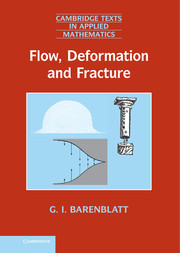 Flow, Deformation and Fracture
Flow, Deformation and Fracture Book contents
- Frontmatter
- Dedication
- Contents
- Foreword
- Preface
- Introduction
- 1 Idealized continuous media: the basic concepts
- 2 Dimensional analysis and physical similitude
- 3 The ideal incompressible fluid approximation: general concepts and relations
- 4 The ideal incompressible fluid approximation: analysis and applications
- 5 The linear elastic solid approximation. Basic equations and boundary value problems in the linear theory of elasticity
- 6 The linear elastic solid approximation. Applications: brittle and quasi-brittle fracture; strength of structures
- 7 The Newtonian viscous fluid approximation. General comments and basic relations
- 8 The Newtonian viscous fluid approximation. Applications: the boundary layer
- 9 Advanced similarity methods: complete and incomplete similarity
- 10 The ideal gas approximation. Sound waves; shock waves
- 11 Turbulence: generalities; scaling laws for shear flows
- 12 Turbulence: mathematical models of turbulent shear flows and of the local structure of turbulent flows at very large Reynolds numbers
- References
- Index
2 - Dimensional analysis and physical similitude
Published online by Cambridge University Press: 05 June 2014
- Frontmatter
- Dedication
- Contents
- Foreword
- Preface
- Introduction
- 1 Idealized continuous media: the basic concepts
- 2 Dimensional analysis and physical similitude
- 3 The ideal incompressible fluid approximation: general concepts and relations
- 4 The ideal incompressible fluid approximation: analysis and applications
- 5 The linear elastic solid approximation. Basic equations and boundary value problems in the linear theory of elasticity
- 6 The linear elastic solid approximation. Applications: brittle and quasi-brittle fracture; strength of structures
- 7 The Newtonian viscous fluid approximation. General comments and basic relations
- 8 The Newtonian viscous fluid approximation. Applications: the boundary layer
- 9 Advanced similarity methods: complete and incomplete similarity
- 10 The ideal gas approximation. Sound waves; shock waves
- 11 Turbulence: generalities; scaling laws for shear flows
- 12 Turbulence: mathematical models of turbulent shear flows and of the local structure of turbulent flows at very large Reynolds numbers
- References
- Index
Summary
In the first chapter we introduced the important concept of an observer and formulated the invariance principle, which states the equivalence (equal rights in mathematical modeling!) of observers. In this chapter we consider what follows from the equivalence of observers whose units of measurement are of the same physical nature but of different magnitudes.
This looks simple but in this case the consequences of the invariance principle are far from trivial. Indeed, we will show that it follows from the principle of equivalence of observers that the functions describing physical laws have a fundamental property which is called generalized homogeneity. This property allows a reduction in the numbers of arguments of these functions and simplifies their determination in a numerical computation or in an experiment. The corresponding procedure is called dimensional analysis. Dimensional analysis is closely related to the rules of the modeling of physical phenomena, which make up the essence of the theory of physical similitude. Dimensional analysis and the theory of similitude will be presented in this chapter in sufficient detail for their use throughout the whole book. More detailed presentation of the subject of this chapter can be found in the author's book (Barenblatt, 2003).
Examples
Example 1. In the autumn of 1940, when the development of atomic weapons was beginning, a fundamental question arose concerning the mechanical action of the energy released during an atomic explosion. An outstanding American expert in explosives, G. B. Kistyakovsky, reported that even if such a weapon were created all its energy would go to radiation and would have essentially no mechanical effect.
- Type
- Chapter
- Information
- Flow, Deformation and FractureLectures on Fluid Mechanics and the Mechanics of Deformable Solids for Mathematicians and Physicists, pp. 29 - 47Publisher: Cambridge University PressPrint publication year: 2014
